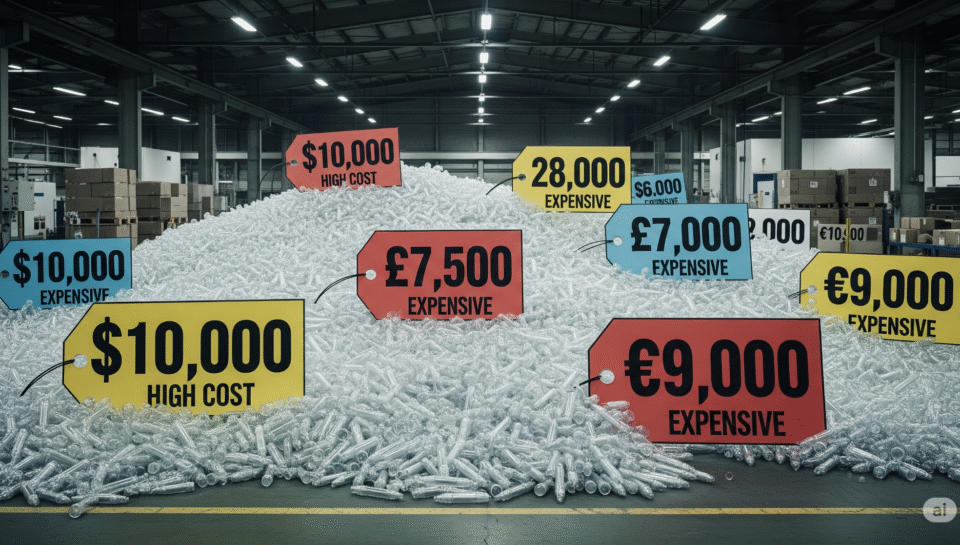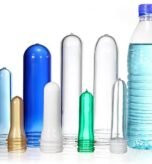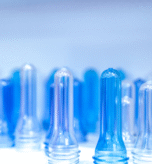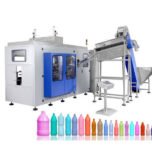If you’ve ever thought you’re shelling out way too much on a PET preform, you’re probably right. This guide dives into everything you need to know, from PET bottle preforms quality to smart PET bottle wholesale buying decisions.
What Are PET Preforms, Anyway?
At its core, a PET preform is a tiny plastic tube that looks nothing like the final bottle you see on store shelves. But once heated and blown into shape, it becomes the plastic bottles we use every day. PET stands for Polyethylene Terephthalate, a lightweight, strong, and food-safe plastic.
These bottle preforms are mass-produced through injection molding, making them a top choice in the beverage, cosmetics, and pharma industries. According to Statista, the global PET preform market size reached 27 million tonnes in 2023, and India is one of the fastest-growing markets.
So, why are PET preforms such a big deal?
- They’re lightweight
- Easily moldable
- Durable
- Cost-effective for mass production
The global demand is sky-high. According to Statista, the global PET market was valued at $23 billion in 2022, and it keeps growing, largely thanks to beverage packaging.
If you’re buying PET bottles wholesale, understanding everything about plastic preforms actually puts you miles ahead of the average buyer. And if you don’t know what you’re buying, you might be overpaying and getting less than you deserve.
From Preform to Bottle: How the Magic Happens
Ever wonder how a tiny bottle preform becomes a full-size PET bottle? It’s like watching a balloon blow up—but way more technical.
The transformation involves a process called stretch blow moulding. Here’s how it works:
Heating
The PET preform is heated evenly using infrared ovens.
Stretching
A rod stretches the heated preform vertically.
Blowing
High-pressure air is used to blow the preform into a mold that shapes it into a full-size bottle.
Cooling
The bottle cools and retains its new shape.
This whole thing takes seconds and is highly efficient, making PET preform bottles a go-to in high-speed production.
Fun fact: A 30g PET preform can become a 1L bottle used for soft drinks or water. And the same mould can be used again and again—saving time and money.
Whether you’re sourcing for PET bottle wholesale needs or small batch requirements, understanding this process helps you pick the right product specs for your use case.
Sounds simple? It is—but only when you’ve got a high-quality PET preform bottle to start with.
A poorly made preform can cause weak bottle walls, leaky caps, and even total production failures. Whether you’re running a soda factory or a small water plant, your entire output depends on solid bottle preforms.
The Hidden Cost of Overpaying: It’s Not Just the Price Tag
Sure, you might shrug off a ₹0.50 difference in the cost of one PET preform. But multiply that by 1 lakh units? You’re looking at ₹50,000 in avoidable expenses.
Here’s what you’re really paying for:
- High resin cost markup (when prices are actually down).
- Inflexible MOQ policies that force you to overstock.
- Inefficient logistics due to bad supplier location.
- Longer downtime if quality issues cause rejects.
According to the India Brand Equity Foundation (IBEF), India’s packaging industry is growing at 18-20% annually, so competition is stiff. Knowing where you’re losing money on bottle preforms helps you stay lean and ahead.
Bottom line? That “slightly expensive” PET preform bottle deal could be draining your margins.
Why Prices Vary So Much for the Same Product
Ever wondered why one vendor quotes ₹4 for a PET preform, while another says ₹6 for what looks like the same thing? Here’s why price differences occur:
Resin Type
Virgin vs. recycled material.
Supplier Location
Logistics cost varies across states.
Mold Quality
Better moulds = better precision = costlier.
Quantity Ordered
More volume, lower per-unit price.
Weight
A 26g and 32g PET preform bottle serves different purposes.
Even colour plays a role! For example, green-tinted PET preforms for carbonated beverages may cost more due to pigment pricing. Pro tip? Don’t just compare prices—compare specs, resin type, and source reliability.
Virgin vs. Recycled PET: Does It Really Matter?
Absolutely, it does.
Virgin PET:
- Made directly from crude oil derivatives.
- Superior clarity and strength.
- Ideal for food-grade PET bottle wholesale.
Recycled PET (rPET):
- Made from used bottles.
- Eco-friendly, cheaper.
- May have slight colour variations.
As per a McKinsey report, rPET adoption could reduce packaging emissions by up to 25%.
In India, BIS (Bureau of Indian Standards) is gradually opening doors for food-grade rPET in packaging, which means your bottle preforms could soon be cheaper and greener, without compromising safety.
How to Spot a High-Quality PET Preform
The quality of the preform is crucial; it directly affects the durability, clarity, and performance of the final product. A poor-quality preform can lead to defects like uneven wall thickness, weak seals, or hazy appearance, ultimately impacting your brand’s reputation. But how can you tell if a PET preform meets high standards? Here’s a quality checklist that you should look for:
- Transparency: Clear, glass-like appearance.
- Weight Consistency: Uniformity is key.
- No Air Bubbles or Black Specks: Signs of poor resin or mould hygiene.
- Perfect Neck Finish: Ensures leak-proof capping.
- No Deformation: Indicates proper storage and quality control.
Use a simple digital weighing scale and calliper to verify spec accuracy. A mismatch in neck diameter can cost you a whole production batch.
The Role of Resin in Pricing: What’s Inside That Matters
PET resin prices are the backbone of PET preform costs. When raw materials like PTA and MEG (main components of PET) go up, so does your cost.
As per Plastemart, PET resin prices in India fluctuate between ₹85–₹110/kg depending on global crude oil trends and demand.
So next time your supplier says “price has gone up,” ask:
- What’s the current PTA/MEG price?
- Are they using domestic or imported resin?
Staying updated on resin trends helps you call out inflated quotes and negotiate smarter.
Buying Local vs. Importing: What’s Really Cheaper?
Choosing between local suppliers and international imports can have a big impact on costs, timelines, and overall efficiency. While each option has its advantages, the right choice depends on your specific needs, budget, and priorities. Factors like pricing, lead times, and reliability all play a role in determining the most cost-effective solution. So, how do you decide what works best for your operation?
Local Sourcing Pros:
- Faster delivery.
- Easier quality checks.
- No customs duty.
Importing Pros:
- Sometimes cheaper if resin is globally low.
- Access to specialised moulds or preform types.
But… importing can add 18–30% in duties and GST, not to mention lead times of 30–60 days. If your PET bottle wholesale orders are frequent and time-sensitive, local sourcing is usually the smarter move.
MOQ (Minimum Order Quantity): When Bigger Isn’t Always Better

If you’ve ever shopped around for PET preforms, you’ve probably noticed that many suppliers require huge order quantities—sometimes as much as 1 lakh (100,000) pieces per purchase. For large-scale plastic preform manufacturers, this might not be a problem. But what if you’re a small business, just testing a new product, or don’t have the storage space for massive stock? A high MOQ can tie up your cash, create storage headaches, and even lead to waste if demand doesn’t meet expectations.
The good news? You don’t always have to accept these high minimums.
Negotiate Split Deliveries
Some suppliers are willing to break down a large order into smaller, staggered shipments. Instead of taking 1 lakh preforms all at once, you could arrange for 25,000 pieces every few weeks. This keeps your inventory manageable while still meeting the supplier’s total order requirement.
Partner with Other Buyers
If your order volume is too low, consider teaming up with other businesses that need the same type of preforms. By pooling your orders together, you can meet the supplier’s MOQ while only taking the quantity you actually need. This works especially well if you know other local bottlers, beverage companies, or packaging businesses that use similar materials.
Buy from Local Distributors (Instead of Factories Directly)
Manufacturers often have strict MOQs, but middlemen—like local distributors or traders—usually stock smaller batches. They buy in bulk from factories and resell in more manageable quantities, sometimes even offering just a few thousand pieces at a time. You might pay a slightly higher per-unit price, but the flexibility can be worth it, especially when you’re still scaling up.
Look for Suppliers with Lower MOQs
Not every supplier demands massive orders. Some specialise in smaller production runs, especially those catering to startups or niche markets. A little extra research could help you find a manufacturer or trader willing to work with your volume needs. Online B2B platforms or industry trade groups can be good places to start your search.
The Dangers of One-Size-Fits-All Preforms
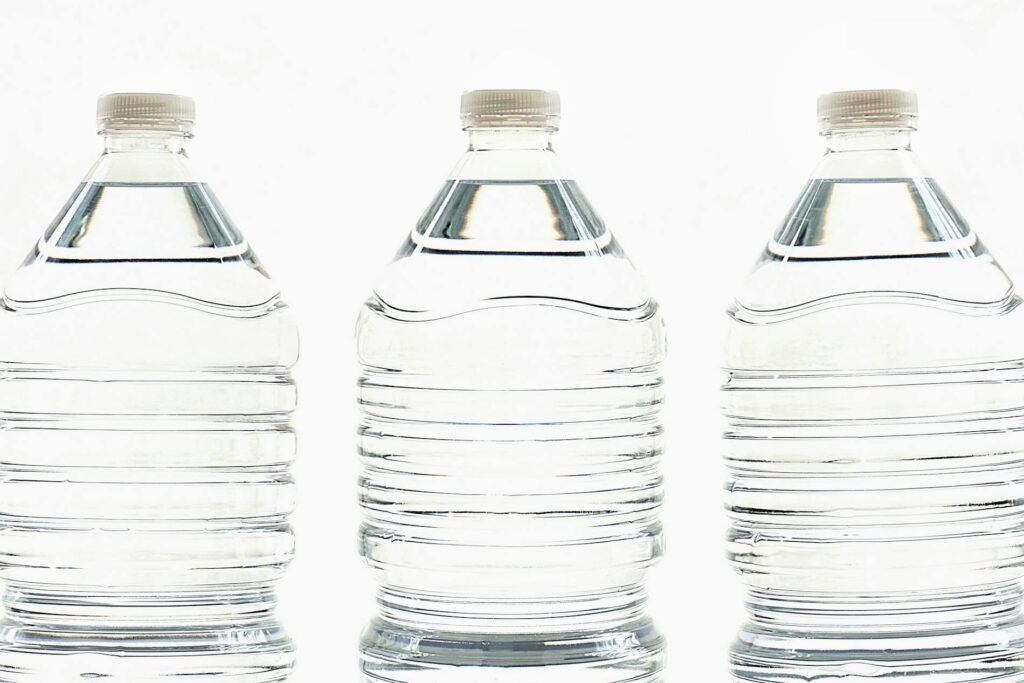
Different liquids = different bottle needs. Using the wrong bottle preform could:
- Cause leakage or pressure build-up.
- Result in under- or over-weight bottles.
- Affect shelf life.
For instance:
- 28mm neck suits most water bottles.
- Preforms for oil bottles are heavier with wider necks.
- Carbonated drinks need higher wall strength.
Choosing the wrong PET preform bottle isn’t just a mismatch—it’s a costly error.
How to Read a Preform Specification Sheet Without Falling Asleep

Yes, it looks like hieroglyphics. But here’s a cheat sheet:
- IV Value (Intrinsic Viscosity): Higher = stronger, clearer preform.
- Weight Tolerance: ±0.1g is acceptable.
- Neck Type: 28mm PCO, Alaska, etc.
- Crystallinity: Affects transparency and strength.
Ask your supplier to explain these before you finalize your PET preforms deal.
Red Flags to Watch Out For When Comparing Quotes
When shopping for PET preforms for your PET bottle wholesale business, getting the best deal is important—but the cheapest price isn’t always the smartest choice. Some suppliers offer suspiciously low quotes that hide serious quality or reliability issues. If you don’t spot the warning signs early, you could end up with unusable PET preform bottles, delayed production, or even regulatory problems.
Huge Price Gaps with No Explanation
If one supplier’s quote is drastically lower than others without a clear reason, be cautious. PET preform prices depend on factors like resin quality, mold precision, and production standards. A price that’s too good to be true might mean:
- The supplier is using substandard PET resin (mixed with impurities or recycled material not suitable for food-grade bottles).
- They’re cutting corners in manufacturing, leading to weak or inconsistent bottle preforms.
- Hidden costs (like extra fees for shipping, duties, or mold adjustments) will appear later.
Missing BIS or ISO Certifications
Quality PET preforms must meet industry standards, especially if they’re used for food or beverage packaging. If a supplier can’t provide:
- BIS (Bureau of Indian Standards) certification (for Indian buyers)
- ISO 9001 (Quality Management) or ISO 22000 (Food Safety) certifications
…it’s a major risk. Uncertified PET preform bottles may fail safety tests, leak, or have structural flaws, leading to product recalls or customer complaints.
Vague Delivery Promises
A supplier who says, “We’ll deliver when ready” without a clear timeline could leave you stranded. Delays in PET preform shipments disrupt production, especially if you’re on tight deadlines for PET bottle wholesale orders. Look for:
- Written commitments on production and delivery schedules.
- Proof of past on-time deliveries (ask for references).
- Transparency about potential delays (like raw material shortages).
No Transparency on Resin Type or Mold Origin
High-quality PET preforms start with:
- Virgin PET resin (for clarity and strength) or FDA-approved recycled resin.
- Precision-made molds that ensure consistent neck finishes and wall thickness.
If a supplier won’t disclose:
- Where their resin comes from (avoid cheap, non-food-grade alternatives).
- Who makes their molds (poorly engineered molds cause defects),
…you could end up with bottle preforms that crack, leak, or get rejected during blow molding.
The “Cheap” Trap: Low Price, High Problems
Choosing the lowest quote might save money upfront, but defective PET preforms lead to:
- Higher rejection rates (wasting time and material).
- Bottle leaks or breaks (damaging your brand reputation).
- Costly reorders or emergency shipments.
Questions Every Buyer Should Ask Their PET Preform Supplier
Here’s your golden list:
- What’s the resin grade and source?
- Is the PET preform food-grade certified?
- What’s your average delivery timeline?
- Do you provide sample testing?
- Can you customize for my bottle preform design?
Never assume. Ask, confirm, and cross-check.
Future-Proofing Your PET Preform Purchases
The industry is changing fast. Here’s what’s coming:
- Lightweight PET preforms to reduce plastic usage.
- Biodegradable PET blends are in testing phases.
- Shift to 100% rPET in many FMCG sectors.
Staying ahead means sourcing smarter, not just cheaper.
Wrapping It Up (But Not the Bottles)
Still overpaying for your PET preforms? Probably. But now you know better.
The next time you shop for bottle preforms or go PET bottle wholesale, you’ll walk in with the confidence of someone who gets the game and knows how not to get played.


